They say… 
Best beer and travel writing award 2015, 2011 -- British Guild of Beer Writers Awards
Accredited Beer Sommelier
Writer of "Probably the best book about beer in London" - Londonist
"A necessity if you're a beer geek travelling to London town" - Beer Advocate
"A joy to read" - Roger Protz
"Very authoritative" - Tim Webb.
"One of the top beer writers in the UK" - Mark Dredge.
"A beer guru" - Popbitch.

|
First published in BEER January 2008 as part of a piece about imperial stouts. For more imperial stouts see previous post.
ABV: 11 per cent
Origin: Newport, Oregon, USA
Website www.rogueales.com
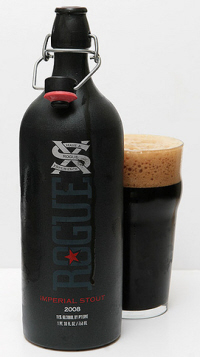 Rogue XS Imperial Stout Founded in 1988, Rogue are now a mainstay of the craft brewing hotbed of the Pacific Northwest and among the handful of small US brewers whose products regularly pop up on British shelves. XS Stout first appeared in 1994 and has since won multiple awards at home. It’s a typically robust and characterful bottle conditioned beer made from a complex mash of seven malts including chocolate and Munich, with rolled oats, Cascade, Willamette and Chinook hops and two secret ingredients.
A black and viscous beer that leaves iodine-like traces on the side of the glass, it pours with a notably dark head and an inky dark fruit, gravy and chocolate aroma. The palate is surprisingly light-textured but bursting with vine fruits, Marmitey malt and drying burry hops. Chocolate and roast come to the fore in a very long finish that turns dry with vegetal resins.
Since I bought my mature tasting sample – the brewery recommends keeping for at least a year – the stout has been relaunched as one of a series of XS beers packed in stylish black ceramic swing-stoppered bottles. Don’t be deterred – although it betrays the American fondness for hops, it’s much less “extreme” than some of its compatriots and stays well within the parameters of the time-honoured Courage style. Albert Le Coq himself would have been proud.
Read more about this beer at ratebeer.com: http://www.ratebeer.com/beer/rogue-imperial-stout/5266/
First published in BEER January 2008 as part of a piece about imperial stouts. For more imperial stouts see previous post.
ABV: 10.5 per cent
Origin: Ansty, Sussex, England
Website www.darkstarbrewing.co.uk
 Dark Star Imperial Stout Dark Star originated at the Evening Star brewpub in Brighton in 1991. Ten years later the brewery, which now owns three pubs, moved to a dedicated plant near Haywards Heath. They don’t do much bottling, but this Imperial Stout is an exception. Brewed annually from Maris Otter pale and crystal malt, malted barley, Target and East Kent Goldings hops, it was originally intended only as a stock beer for blending but according to the brewery’s Nigel Hartley “word got out” and it’s now in its third year as a Real Ale in a Bottle.
A black beer with a thick yellowy fawn head, it yields an intoxicatingly fruity and estery aroma with raisins and petrol hints. A slick winey, cakey palate has dark roast malt and blackcurrant with tingling alcohol on the tongue. A coffeeish swallow leads to a warming malt finish with resiny, peppery hops and a late whiff of mature Camembert. Fruitier than some, this is a delightful beer that should mature well.
For more imperial stouts, see next post.
Read more about this beer at ratebeer.com: http://www.ratebeer.com/beer/dark-star-imperial-stout/55061/
First published in BEER January 2008 as part of a piece about imperial stouts. For more imperial stouts see previous post.
ABV: 10 per cent
Origin: Fraserburgh, Aberdeenshire, Scotland
Website www.brewdog.com
 BrewDog Paradox James Watt and Martin Dickie opened Grampian-based Brewdog only a year ago but they’ve already caused a stir with their original and distinctive brews, and a youthful approach that’s more like an iconoclastic US craft brewer than a British real ale micro. Paradox, based on their Rip Tide Imperial Stout and matured in single malt whisky casks supplied by whisky merchants Duncan Taylor & Co, also nods across the Atlantic where collectable small-run cask-matured beers have a cult following.
The bottling I tried was from a Caol Ila cask, and the smoky, peaty whiff of Islay was instantly recognisable on the complex malt and liquorice aroma. The juicy palate is lighter and slightly sweeter than some stouts but still full of flavour and slightly yoghurty, while a long tart finish has hints of apple, drying out with burry hops and whisky-scented wood over generous smooth malt.
Although filtered and not bottle conditioned, this is a fine and innovative beer and I look forward to trying alternative versions matured in different casks.
For more imperial stouts see next post.
Read more about this beer at ratebeer.com: http://www.ratebeer.com/beer/brewdog-paradox-islay-batch-001/73221/
First published in BEER January 2008 as part of a piece about imperial stouts.
ABV: 9%
Origin: Esen, West-Vlaanderen
Website: www.dedollebrouwers.be
 De Dolle Brouwers Special Extra Export Stout Imperial Stout was a souped-up 19th century development of London porter that found favour in Tsarist. A century later the sole surviving original brand from Barclay Perkins ended up in the dubious custodianship of Courage as one of the famous five bottle conditioned beers still in production at the inception of CAMRA. The giant brewer finally got round to clearing out its attic in 1993 when the last brew emerged from John Smith’s at Tadcaster.
The loss of Courage Russian Stout sparked renewed interest in the style, particularly across the Atlantic – it was for the US market that Harvey’s recreated the recipe originally brewed for 19th century exporter A Le Coq, who pioneered sales of English stout to Russia. Brewers in the Low Countries and Scandinavia have since entered the fray and in the US itself the style’s high gravity, generous hopping, strong flavours and historic pedigree have endeared it to a generation of “Extreme Beer” brewers.
Imperial Stout isn’t the sort of thing you’ll find on every supermarket shelf and the more flamboyant US versions remain unseen in Britain, but you should be able to source the four beers featured here from UK specialists. Other good examples you might encounter are from Alvinne (Podge), Bartrams, Brooklyn (Black Chocolate), Pitfield, Proef (SNAB Czaar Peter) and Thornbridge, plus of course Harvey’s excellent and very traditional version – all of them fit for a Tsar.
De Dolle Brouwers, the “mad brewers”, first fired their mash tuns in 1980 when cycling and home brewing enthusiasts the Herteleer brothers took over an ailing 1835 rural brewery. They’re now among the best-known and best-loved of new generation Belgian brewers for their distinctive and eccentrically marketed bottle conditioned beers.
The brothers are long-term admirers of British stouts and their own is partly inspired by a Whitbread recipe but uses their house yeast which includes a lactic culture – as Kris Herteleer says, two centuries ago British stouts would also have been sour. It’s brewed from pale, roasted and caramalts – interestingly there’s no roasted barley – and hopped with whole Nugget flowers from Poperinge.
This lively dark ruby beer has an incense-laden aroma with notes of cardamom and smelling salts. The blackcurrant and chocolate palate has something of the thick gravy-like quality of the old Courage version and a notable sourness from the lactic yeast. Brown sugar notes emerge before a mouth-numbing finish with ashy chocolate roast well-blended with burry hops, dark marmalade and sultana fruit. A little wild when young, perhaps, but it will mellow slowly for years.
For more imperial stouts, see next post.
Read more about this beer at ratebeer.com: http://www.ratebeer.com/beer/de-dolle-extra-export-stout/31936/
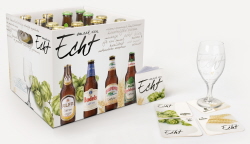 De Smaak van Echt 2010 Following the success of a similar initiative last year, four Dutch independent family brewers have worked together again to launch De Smaak van Echt 2010 (The Real Taste), a gift pack featuring four new and exclusive one-off beers, all warm fermented and unpasteurised.
Alfa of Schinnen, Limburg, has contributed Alfa Echt 2010 (5.5%), a lightly cloudy amber beer with a touch of caramel and herbal hop bitterness. Budels Echt 2010 (5%), from Budel in Noord-Brabant, is a German-style wheat beer with a genuine German yeast. From Gulpen in Limburg comes Gulpener Echt 2010 (5.5%), an unfiltered spelt beer with a slight fruity sourness. Finally Lindeboon, of Neer, Limburg, offers Lindeboom Echt 2010 (5.5%), a pure malt finely hopped light blond.
All the beers are available only in the packs, not individually, with each pack containing three 300ml bottles of each beer, a special branded tasting glass, four beermats and an information booklet. They can be ordered from the participating brewers from the end of May.
 Brouwerij Florindia A number of new brewing enterprises have launched in the Netherlands in the past year, reports PINT Nieuws, journal of Dutch beer consumers’ organisation PINT.
Launched in April 2009, Brouwerij Florindia is the brainchild of Mikael Kok, formerly a home brewer whose commercial ambitions developed brewing beer as gifts for clients of his international IT business. It’s based in Heerhugowaard, near Alkmaar in the province of North Holland, originally a small village on the edge of a drained peat fen known as the Waardsepolder but expanded since the 1960’s into a major new town with a population currently at 52,000 and planned to double over the next few decades. Perhaps surprisingly, Heerhugowaard enjoys a decent beer culture with several specialist pubs and shops, and Florindia, named after Mikael’s daughters Floor and India, makes a point of selling through this local market.
As with a number of small Dutch brewers, Florindia doesn’t own its own plant, though there are plans for a brewpub at some stage. For the moment all the beers are brewed at de Praght in nearby Dronten, where head brewer Maurice Bouma works closely with Mikael on small batches of 5ool. There’s an very special local connection too in the hopping — some of the bittering hops are grown by Mikael himself on a local property owned by his father-in-law.
The regular beers are the standard Waerdsepolderbier (5.3%), a pils-style beer with pils and cara-amber malt, malted wheat, Northern Brewer, Premiant and Perle hops (34 IBU) and Czech yeast; a blond (5.3%) made to a similar recipe but with Kölsch yeast; and a tripel (8%) with pils, Munich type 1 and cara-Munich tupe 3 malt, malted wheat, similar hops to the pils and a Trappist yeast. Occasional specials include a stout, a strong blond Duvel-style ale and a 12% barley wine called Waerdse Reus. Discussions are underway with supermarkets for wider distribution. For more see http://florindia.nl.
Slightly further south, Amsterdam acquired another brewing firm in November 2009 — Brouwerij Zeeburg, borrowing its name from the part of the city where founders Jan Ronald Crans and Robert van Lil live, which in turn is named after a well-known inn and brewpub that stood there in the early 18th century. Once again the brewers currrently lack a brewery, and their only beer so far, the well-received Zeeburg Tripel, currently originates from fellow Amsterdam brewery De Prael. There are plans for a brewpub. For more see www.brouwerijzeeburg.nl.
A brewery that does have its own kit is Stadsbrouwerij Wittenburg in Zevenaar, Gelderland, and it’s just been expanded, with a copper, three fermentation vessels and three lagering tanks arriving on 25 March 2010, bought second hand from a German brewpub for a bargain price of €100,000. Brewery partners Peter van Schijndel, Jaap Blok, Toon Berens and Rik den Breejen brew under the brand De Jonkheer — the name is taken from the title of a minor noble, as the brewery is based on the property of Jonkheer van Nispen van Zevenaaar. Founded in 2008, the brewery now offers four beers: a Wit (wheatbeer, 5%), a Blond (6.2%), a Dubbel (7%) and a Tripel (7.8%). For more see www.stadsbrouwerijwittenburg.nl.
A wealth of detail about Dutch brewers can be found (in Dutch) on the newly revamped Dutch beer portal at www.cambrinus.nl.
First published in BEER December 2007 as part of a piece about strong beers for the festive season. For more strong festive beers see previous post.
ABV: 9 per cent
Origin: Montignies-sur-Roc, Hainaut, Wallonie
Website www.abbaye-des-rocs.com
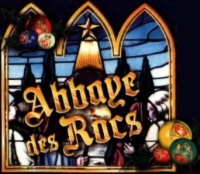 Abbaye des Rocs Spéciale Noël Belgium excels at producing strong bottle conditioned ales for laying down, including seasonal specials that are well worth keeping for a few years after release. This is a great example from the rural commune of Honnelles near the French border. Abbaye des Rocs isn’t an official abbey brewer – the abbey in question now lies in ruins – but it is an outstanding brewery that since 1979 has blossomed from a weekend hobby into one of Belgium’s best new generation micros.
The Noël is based on the brewery’s flagship Abbaye des Rocs dark ale brewed from seven different malts and Belgian, German and Czech hops, with subtle spicing. It pours a hazy ruby colour with a thick sediment and a good yellow head.
A seedy, spicy dried fruit and juicy malt aroma leads to a big mouth-numbing palate that’s notably dry and hoppy for the style, unfolding slowly with rich fruity grape and incense flavours. A satisfying finish is initially quite stern and dry with mineral notes, warmed by alcohol and a subtle background sherried sweetness.
Some brewers of Christmas beers seem to take the traditional sweet baked goods of the season as their model and produce sickly concoctions: that’s certainly not the case in this refined and delicious beer that should help ensure your Noël is indeed joli.
Read more about this beer at ratebeer.com: http://www.ratebeer.com/beer/abbaye-des-rocs-speciale-noel/9446/
First published in BEER December 2007 as part of a piece about strong beers for the festive season. For more strong festive beers see previous post.
ABV: 11.5 per cent
Origin: Middleton Junction, Manchester, England
Website www.jwlees.co.uk
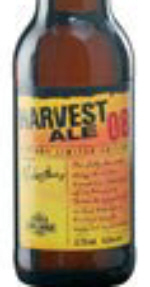 JW Lees Harvest Ale The term “vintage”, which strictly speaking refers to the grape harvest, is often misapplied to beer – unlike wine, beer is made from dry ingredients and its provenance doesn’t depend on one particular year and season. But this barley wine from Manchester family brewer Lees is an exception.
Harvest Ale is brewed annually in limited quantities that season’s harvest of Maris Otter barley malt and East Kent Goldings hops, and released, vintage-dated, in December. A special yeast strain is used and, although the beer isn’t Real Ale in a Bottle, it gains complexity and loses sweetness with age, and even throws a sediment.
A well-matured 2002 poured dark ruby-brown with a fizzy and quickly declining nutmeg-coloured head. The heady fumes of a rich, winy, Dundee cake and olive aroma heralded a still sweet but fine and oily malt palate with cherry fruit, artichokes, port and salt. A very long and mouth coating sherryish finish developed chewy marmalade notes and a hint of wood.
I’ve not yet been able to track down any of the occasional special releases matured in port, sherry and whisky casks – a special treat for Christmases yet to come.
More strong beers for the festive season in the next post.
Read more about this beer at ratebeer.com: http://www.ratebeer.com/beer/jw-lees-harvest-ale/6070/
First published in BEER December 2007 as part of a piece about strong beers for the festive season.
ABV: 11.7 per cent
Origin: Whimple, Devon, England
Website www.ohanlons.co.uk
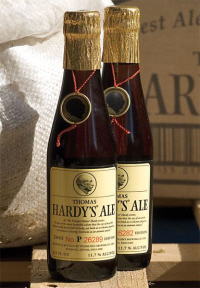 O'Hanlon's Thomas Hardy's Ale When it comes to the festive season, I’m something of a bah humbug type by nature, but one of the things I do look forward to is venturing into my beer cellar. Or rather, the dark cupboard in which, for the past few years, I’ve had the remarkable self-discipline to stash bottles that deserve time to think about how they’re going to taste.
It’s not just a beer geek’s affectation – a good beer of reasonable strength really will develop complexity with age, especially if it’s bottled conditioned. Sharp hoppy flavours gain comfortably rounded corners, malt and fruit learn to mingle harmoniously and unexpected tastes emerge from the complex chemistry of secondary fermentation.
Setting a regular date to dip into your hoard is a good way of resisting the temptation to open the bottles too soon. And since many of the beers that benefit from cellaring make great winter warmers, enjoyed at leisure, the Yuletide holiday provides the perfect excuse.
Thomas Hardy’s is the ultimate British cellaring beer, and many readers will already be familiar with its fascinating story. Inspired by a quote from the eponymous novelist which still appears on the label, it was first brewed in 1968 to mark the 40th anniversary of his death. It was originated by family brewer Eldridge Pope of Dorchester, a town which, under the name Casterbridge, is a key location in Hardy’s Wessex novels.
Launching a super strength sedimented ale was an odd move at a time when most British brewers had abandoned bottle conditioning, slashed gravities and were now scrambling to dump cask. But someone at EP must have had faith that there was a niche in the market for a specialist brew and, as one of the famous five bottle conditioned British ales still in production at the inception of CAMRA, the ale became revered among the first generation of modern beer connoisseurs.
In 1997 the Dorchester brewery closed, a victim of the mania for severing brewing from retailing that gripped many traditional independents in the wake of the Beer Orders. Its famous strong ale joined the long list of lost classics until, in 2003, it was rescued thanks to interest from the burgeoning beer enthusiast community in the United States. The appropriately named Phoenix Imports of Maryland acquired the rights and commissioned first class microbrewery O’Hanlon’s to recreate the beer.
Thomas Hardy’s Ale is made mainly from pale malt and maltose syrup with only a touch of crystal malt – much of the colour comes from a long 200-minute boil. Hopped with Challenger, Goldings, Styrian Goldings and Northdown, it’s fermented for three months, hopped again and conditioned for two months before being bottled unfiltered with a vintage date. If looked after, it’ll continue to mature in the bottle for 25 years or more.
A 2006 vintage poured a delightful burgundy colour with very little head and low condition, and a sweetish cakey, winy and fruity aroma with a hint of figs. Fresh orange, peaches and marzipan fruit cake were evident on a smooth, nectar-like palate leading to a warming and very long finish with well-balanced burry hops, creamy toffee and a woody tang.
Bottles of the later Dorchester vintages have revealed soapy and peppery notes, spices, tannic red wine and marsala flavours. So don’t just buy one – get some spares and grow old gracefully together.
More strong festive beers in next post.
Read more about this beer at ratebeer.com: http://www.ratebeer.com/beer/ohanlons-thomas-hardys-ale-vintage-2003-and-later/31915/
First published in BEER November 2007 as part of a piece about beers from Booths supermarkets. More Booths beers in previous post.
ABV: 7.2 per cent
Origin: Witney, Oxfordshire
Website www.brakspear-beers.co.uk
 Wychwood Brakspear Triple Like Young’s, Brakspear is another revered Thames-side name now achieving good results at a new location. Most readers will be familiar with the story of how beer marketing company Refresh UK acquired Brakspear’s brands and most of its brewing kit when the owning family sold off their historic Henley brewery for redevelopment, and after a period of contract brewing installed both brands and kit in their own separate section of the Wychwood brewery in Witney [now owned by Marstons].
Triple was created by head brewer Jeremy Moss to celebrate the return of the brand to Oxfordshire. The unusually high strength may mislead you into thinking it’s in the strong golden Belgian abbey style but in fact it’s more a souped-up English bitter, deep amber in colour with a thick yellowish head – the name alludes to the fact that the beer is hopped and fermented three times. Maris Otter pale, crystal and black malts, Northdown hops on the boil and Cascade on the aroma make up the recipe.
A toffeeish, sacky and spicy hop aroma leads to a rich nutty palate with a powerful dose of hops and hints of almonds, yeast and orange marmalade – but creamy, slightly syrupy malt dominates, recalling Speyside malt whisky. A sappy and slightly warming finish has estery varnish notes and a controlled but quite peppery hop bite. A fine sipping beer that will mature past its best before date, and you can even look up the bottling date of each individually numbered bottle on the brewery website.
Read more about this beer at ratebeer.com: http://www.ratebeer.com/beer/brakspear-triple/46132/
|
Cask  This pioneering new book explains what makes cask beer so special, and explores its past, present and future. Order now from CAMRA Books. Read more here. This pioneering new book explains what makes cask beer so special, and explores its past, present and future. Order now from CAMRA Books. Read more here.
London’s Best Beer  The fully updated 3rd edition of my essential award-winning guide to London’s vibrant beer scene is available now from CAMRA Books. Read more here. The fully updated 3rd edition of my essential award-winning guide to London’s vibrant beer scene is available now from CAMRA Books. Read more here.
|














